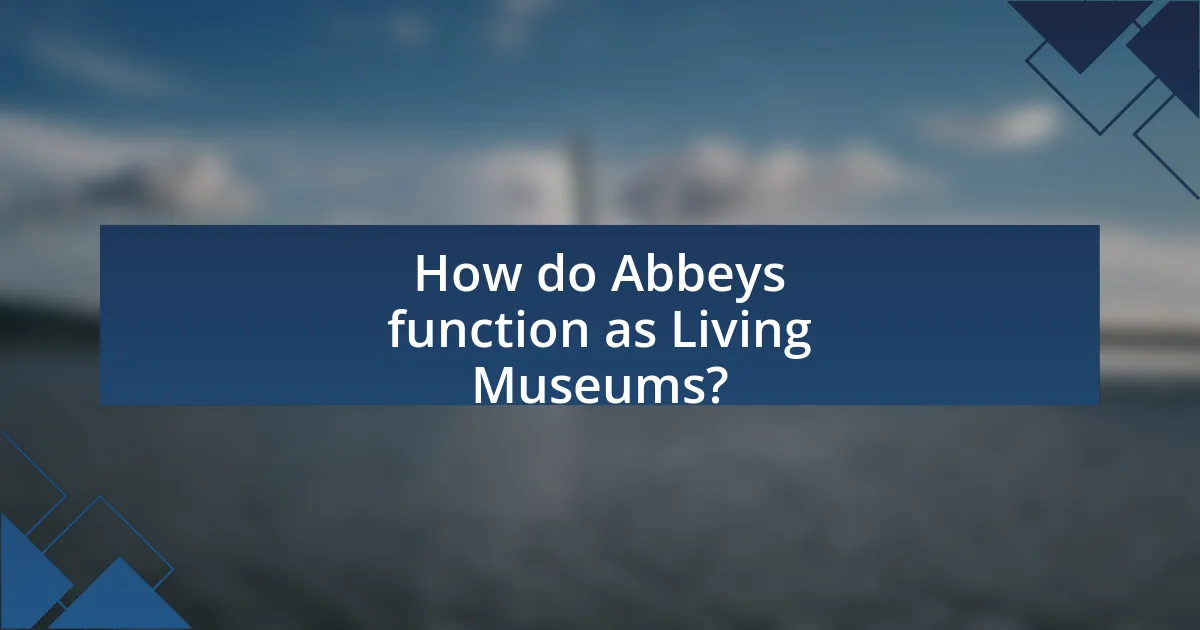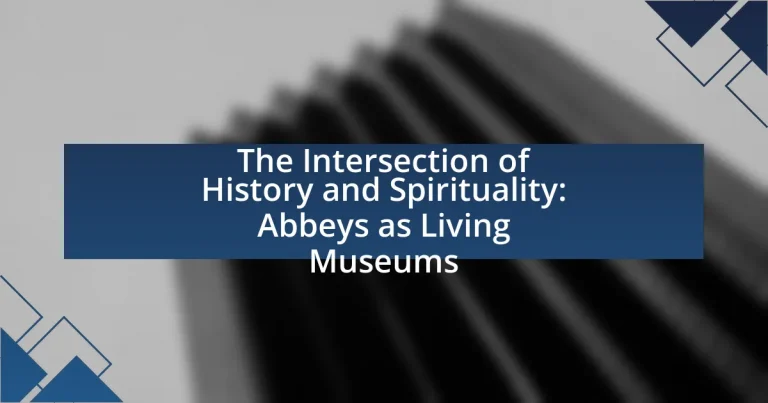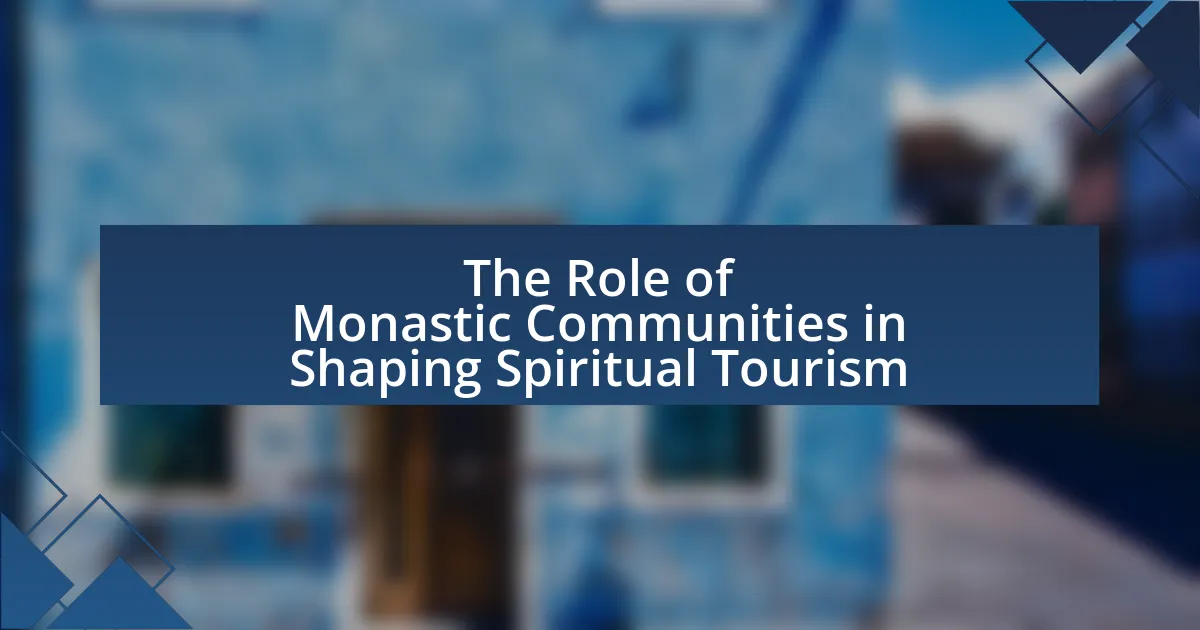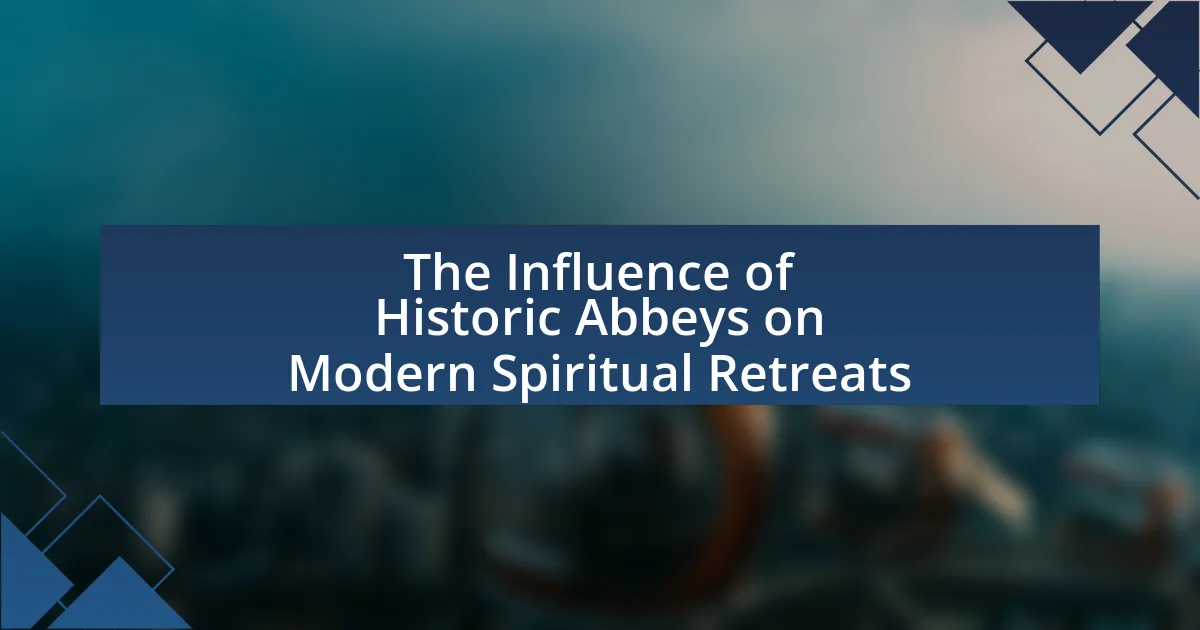Abbys are religious complexes that historically functioned as centers for monastic life, playing a vital role in the preservation of knowledge, culture, and spirituality, particularly during the Middle Ages. This article explores the origins and evolution of abbeys, their significance in medieval society, and their influence on local and national histories. It also examines the relationship between abbeys and spirituality, their function as living museums, and the challenges they face in maintaining their heritage. Additionally, the article highlights the experiences visitors can expect, including spiritual practices and educational programs, while emphasizing the importance of etiquette and preparation for a meaningful visit.

What are Abbeys and Their Historical Significance?
Abbeys are religious complexes that historically served as centers for monastic life, where monks or nuns live, work, and worship. They played a crucial role in the preservation of knowledge, culture, and spirituality throughout the Middle Ages, often becoming hubs for education, agriculture, and community support. For instance, the Abbey of Cluny, founded in 910 in France, became a model for monastic reform and significantly influenced the development of Western monasticism. Additionally, abbeys often housed important manuscripts and art, contributing to the cultural heritage of their regions. Their architectural styles, such as Romanesque and Gothic, also reflect the historical periods in which they were built, showcasing the intersection of spirituality and artistry.
How did Abbeys originate and evolve over time?
Abbeys originated in the early Christian era as monastic communities dedicated to religious life, with the first known abbey being founded by St. Benedict in the 6th century in Italy. These institutions evolved over time, expanding their roles from purely spiritual centers to include agricultural, educational, and cultural functions, particularly during the Middle Ages when they became centers of learning and art. The architectural styles of abbeys also transformed, reflecting the prevailing Gothic and Romanesque influences, which can be seen in structures like the Abbey of Cluny in France. By the Renaissance, many abbeys had become repositories of art and knowledge, further solidifying their status as living museums that preserved both spiritual and cultural heritage.
What role did Abbeys play in medieval society?
Abbeys served as crucial centers of religious, cultural, and economic life in medieval society. They functioned as places of worship, education, and community support, often housing monks or nuns who dedicated their lives to spiritual practices and the preservation of knowledge. Historical records indicate that abbeys were instrumental in the development of agriculture, as they managed vast lands and introduced innovative farming techniques, contributing to local economies. Additionally, abbeys acted as repositories of art and literature, preserving manuscripts and fostering the creation of religious and secular works, thus playing a vital role in the cultural heritage of the time.
How have Abbeys influenced local and national histories?
Abbeys have significantly influenced local and national histories by serving as centers of religious, cultural, and economic activity. Historically, abbeys were pivotal in the establishment of communities, often becoming the focal point for education, agriculture, and trade. For instance, the Cistercian Abbey of Clairvaux in France not only contributed to the spread of monasticism but also played a crucial role in agricultural innovations that shaped the region’s economy during the Middle Ages. Additionally, abbeys often housed important manuscripts and artifacts, preserving knowledge and culture that would otherwise have been lost, thereby impacting national identity and heritage. The dissolution of abbeys in England during the Reformation, such as the dissolution of the monasteries under Henry VIII, dramatically altered the social and political landscape, redistributing land and wealth and influencing the course of English history.
What is the relationship between Abbeys and spirituality?
Abbeys serve as centers of spirituality, embodying a physical and communal space for religious practice and contemplation. Historically, abbeys have been established by monastic communities dedicated to prayer, meditation, and the pursuit of a spiritual life, often following specific religious orders such as the Benedictines or Cistercians. These institutions not only provide a sanctuary for individual spiritual growth but also foster a collective experience of faith through communal worship, rituals, and the observance of religious traditions. The architecture and art within abbeys often reflect spiritual themes, enhancing the atmosphere conducive to reflection and devotion.
How do Abbeys serve as centers of spiritual practice?
Abbys serve as centers of spiritual practice by providing a dedicated space for communal worship, meditation, and reflection. These religious communities often follow specific monastic rules, such as those established by St. Benedict, which emphasize prayer, work, and study. The architecture and layout of abbeys, including chapels and cloisters, facilitate a serene environment conducive to spiritual growth. Historical records indicate that abbeys have been pivotal in preserving religious traditions and texts, further solidifying their role as spiritual hubs. For example, the Abbey of Cluny, founded in 910, became a model for monastic reform and spiritual renewal across Europe, influencing countless other abbeys in their spiritual practices.
What are the different spiritual traditions represented in Abbeys?
Abbeys represent various spiritual traditions, primarily including Christianity, Buddhism, and Hinduism. In Christianity, abbeys are often associated with monastic orders such as Benedictines, Cistercians, and Trappists, emphasizing communal living, prayer, and work. Buddhism features abbeys known as monasteries, where monks engage in meditation and teachings of the Buddha. Hinduism includes ashrams, which serve as spiritual retreats for study and devotion. Each of these traditions reflects unique practices and beliefs, contributing to the rich tapestry of spiritual life within abbeys.

How do Abbeys function as Living Museums?
Abbys function as living museums by preserving and showcasing historical architecture, art, and monastic traditions while actively engaging in spiritual practices. These institutions often maintain their original structures, allowing visitors to experience the historical context of the site. For example, many abbeys feature ancient manuscripts, religious artifacts, and artworks that reflect their cultural significance, such as the illuminated texts found in the Abbey of St. Gall, which date back to the 9th century. Additionally, abbeys often host guided tours, workshops, and events that educate the public about their historical and spiritual heritage, thus bridging the gap between past and present. This dual role as both a place of worship and a site of historical education reinforces their status as living museums.
What elements contribute to the museum aspect of Abbeys?
The elements that contribute to the museum aspect of abbeys include their historical artifacts, architectural significance, and the preservation of cultural heritage. Historical artifacts such as manuscripts, religious texts, and liturgical items provide insight into the monastic life and spiritual practices of past centuries. The architectural design of abbeys, often showcasing styles from various historical periods, serves as a testament to the craftsmanship and artistic expression of their time. Additionally, abbeys often house collections that reflect the local culture and history, making them repositories of knowledge and tradition. For example, the Abbey of Saint Gall in Switzerland is recognized for its well-preserved medieval library, which is a UNESCO World Heritage site, highlighting the abbey’s role in preserving knowledge and culture.
How do Abbeys preserve historical artifacts and architecture?
Abbys preserve historical artifacts and architecture through meticulous conservation practices and dedicated stewardship. These institutions often employ trained conservators who assess the condition of artifacts and structures, implementing restoration techniques that adhere to historical accuracy. For example, many abbeys utilize traditional materials and methods in their restoration efforts, ensuring that any repairs maintain the original aesthetic and structural integrity. Additionally, abbeys frequently engage in archival research to document their history and the provenance of artifacts, which aids in their preservation efforts. This commitment to historical accuracy and conservation is evident in the ongoing maintenance of structures like the Abbey of Westminster, which has been preserved for over a thousand years, showcasing the effectiveness of these practices.
What educational programs do Abbeys offer to visitors?
Abbeys offer a variety of educational programs to visitors, including guided tours, workshops, and lectures focused on their historical, architectural, and spiritual significance. These programs often include insights into monastic life, the history of the abbey, and the role of the abbey in the local community. For example, many abbeys provide workshops on traditional crafts such as brewing, baking, or manuscript illumination, which highlight the skills practiced by monks throughout history. Additionally, lectures may cover topics related to theology, art, and the preservation of cultural heritage, reinforcing the abbey’s role as a living museum that educates the public about its rich history and spiritual traditions.
Why are Abbeys important for cultural heritage?
Abbeys are important for cultural heritage because they serve as historical landmarks that preserve architectural styles, religious practices, and community traditions. These structures often date back centuries, reflecting the socio-political and spiritual contexts of their time. For instance, the architecture of abbeys, such as Gothic or Romanesque styles, provides insight into the artistic and engineering advancements of their respective eras. Additionally, abbeys have historically been centers of learning, art, and agriculture, contributing to the cultural and economic development of their regions. Their continued existence allows for the study and appreciation of historical narratives, making them vital to understanding cultural evolution.
How do Abbeys promote cultural understanding and appreciation?
Abbys promote cultural understanding and appreciation by serving as repositories of history, art, and spirituality that reflect diverse cultural narratives. These institutions often host educational programs, guided tours, and exhibitions that showcase their historical significance and artistic heritage, allowing visitors to engage with various cultural traditions. For instance, many abbeys feature architectural styles and artworks that represent different historical periods and cultural influences, such as Romanesque, Gothic, and Baroque, which can enhance visitors’ understanding of the evolution of art and architecture across cultures. Additionally, abbeys frequently engage in community outreach and interfaith dialogues, fostering a sense of shared heritage and mutual respect among different cultural and religious groups.
What challenges do Abbeys face in maintaining their heritage?
Abbeys face significant challenges in maintaining their heritage, primarily due to financial constraints, declining monastic populations, and the need for modernization. Financially, many abbeys rely on donations and tourism, which can fluctuate, making it difficult to fund preservation efforts. The decline in monastic populations limits the number of individuals available to uphold traditional practices and maintain the physical sites. Additionally, the necessity to modernize facilities to meet contemporary standards can conflict with the preservation of historical integrity. These factors collectively hinder the ability of abbeys to sustain their cultural and spiritual heritage effectively.

What experiences can visitors expect at Abbeys?
Visitors at abbeys can expect a rich blend of historical and spiritual experiences. These sites often feature guided tours that provide insights into their architectural significance, historical context, and the monastic life that has been practiced for centuries. Many abbeys also host religious services, allowing visitors to participate in or observe traditional rituals, which enhances the spiritual atmosphere. Additionally, visitors can explore beautiful gardens and serene landscapes that are integral to the abbey’s setting, contributing to a sense of peace and reflection. The combination of educational tours, spiritual engagement, and tranquil surroundings makes abbeys unique destinations for those interested in history and spirituality.
How do Abbeys engage visitors spiritually and historically?
Abbeys engage visitors spiritually and historically by providing immersive experiences that connect them to centuries of religious practices and architectural heritage. Visitors often participate in prayer services, meditation, and guided tours that highlight the abbey’s role in monastic life, fostering a sense of spiritual reflection. Historically, abbeys serve as repositories of art, manuscripts, and artifacts, showcasing their significance in the development of Western civilization. For example, the Abbey of Westminster in London, founded in 960 AD, not only serves as a place of worship but also as the site of royal ceremonies, illustrating its historical importance. This combination of spiritual engagement and historical context allows visitors to appreciate the profound impact abbeys have had on culture and faith throughout the ages.
What types of tours and activities are available at Abbeys?
Abbys offer guided tours, educational workshops, and spiritual retreats. Guided tours typically include historical insights into the architecture, art, and monastic life, often led by knowledgeable staff or monks. Educational workshops may focus on topics such as meditation, traditional crafts, or the history of the abbey, providing hands-on experiences. Spiritual retreats allow visitors to engage in contemplative practices, often set in serene environments conducive to reflection and prayer. These activities highlight the abbeys’ roles as both historical sites and centers for spiritual growth.
How can visitors participate in spiritual practices at Abbeys?
Visitors can participate in spiritual practices at Abbeys by attending scheduled services, engaging in guided meditation, and joining communal prayers. Many Abbeys offer daily Mass or prayer services that are open to the public, allowing visitors to experience the liturgical traditions firsthand. Additionally, some Abbeys provide opportunities for silent retreats or workshops focused on spiritual growth, where participants can immerse themselves in the contemplative atmosphere. These practices are rooted in the historical significance of Abbeys as centers of spirituality and community, reflecting their ongoing role in fostering spiritual engagement.
What are the best practices for visiting Abbeys as living museums?
The best practices for visiting Abbeys as living museums include respecting the spiritual significance of the site, adhering to visitor guidelines, and engaging with the history presented. Visitors should maintain a quiet demeanor to honor the monastic atmosphere, as many abbeys are still active places of worship. Following posted rules, such as photography restrictions and designated paths, ensures the preservation of the site. Engaging with guided tours or informational materials enhances understanding of the abbey’s historical context, as many abbeys date back centuries and reflect significant architectural and cultural heritage. For example, the Abbey of Westminster in London, established in 960 AD, serves as both a religious site and a historical landmark, illustrating the importance of respecting its dual role.
How can visitors prepare for a meaningful experience at an Abbey?
Visitors can prepare for a meaningful experience at an Abbey by researching its history, understanding its spiritual significance, and planning their visit around scheduled services or events. Researching the Abbey’s background allows visitors to appreciate its architectural features and historical context, which enhances their overall experience. Understanding the spiritual practices and traditions observed at the Abbey fosters a deeper connection during their visit. Additionally, attending services or guided tours provides insights into the Abbey’s role in the community and its ongoing spiritual life, making the visit more enriching.
What etiquette should visitors observe while at an Abbey?
Visitors at an Abbey should observe respectful behavior, including maintaining silence, dressing modestly, and refraining from using mobile devices. Respectful behavior is essential as Abbeys are places of worship and reflection, often housing historical artifacts and architecture significant to cultural heritage. For instance, many Abbeys have specific guidelines that prohibit loud conversations and photography in sacred areas to preserve the sanctity of the space and the experience for all visitors.





